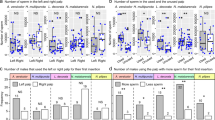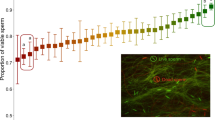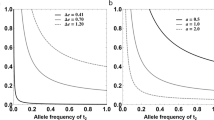Abstract
Postcopulatory sexual selection comprises both sperm competition, where the sperm from different males compete for fertilization1, and cryptic female choice, where females bias sperm use in favour of particular males2. Despite intense current interest in both processes as potential agents of directional sexual selection3, few studies have attributed the success of attractive males to events that occur exclusively after insemination. This is because the interactions between pre- and post-insemination episodes of sexual selection can be important sources of variation in paternity4. The use of artificial insemination overcomes this difficulty because it controls for variation in male fertilization success attributable to the female's perception of male quality, as well as effects due to mating order and the relative contribution of sperm from competing males5. Here, we adopt this technique and show that in guppies, when equal numbers of sperm from two males compete for fertilization, relatively colourful individuals achieve greater parentage than their less ornamented counterparts. This finding indicates that precopulatory female mating preferences can be reinforced exclusively through postcopulatory processes occurring at a physiological level. Our analysis also revealed that relatively small individuals were advantaged in sperm competition, suggesting a possible trade-off between sperm competitive ability and body growth.
This is a preview of subscription content, access via your institution
Access options
Subscribe to this journal
Receive 51 print issues and online access
$199.00 per year
only $3.90 per issue
Buy this article
- Purchase on Springer Link
- Instant access to full article PDF
Prices may be subject to local taxes which are calculated during checkout


Similar content being viewed by others
References
Parker, G. A. in Sperm Competition and Sexual Selection (eds Birkhead, T. R. & Møller, A. P.) 3–54 (Academic, San Diego, 1998)
Eberhard, W. G. Female Control: Sexual Selection by Cryptic Female Choice (Princeton Univ. Press, Princeton, 1996)
Birkhead, T. R. & Pizzari, T. Postcopulatory sexual selection. Nature Rev. Genet. 3, 262–273 (2002)
Birkhead, T. R. & Møller, A. P. (eds) Sperm Competition and Sexual Selection (Academic, San Diego, 1998)
Birkhead, T. R. Defining and demonstrating postcopulatory female choice—again. Evolution 54, 1057–1060 (2000)
Simmons, L. W. Sperm Competition and its Evolutionary Consequences in the Insects (Princeton Univ. Press, Princeton, New Jersey, 2001)
Dziuk, P. J. Factors that influence the proportion of offspring sired by a male following heterospermic insemination. Anim. Reprod. Sci. 43, 65–68 (1996)
Evans, J. P. & Magurran, A. E. Patterns of sperm precedence and predictors of paternity in the Trinidadian guppy. Proc. R. Soc. Lond. B 268, 719–724 (2001)
Sheldon, B. C. Male phenotype, fertility, and the persuit of extra-pair copulations by female birds. Proc. R. Soc. Lond. B 257, 25–30 (1994)
Blount, J. D., Møller, A. P. & Houston, D. C. Antioxidants, showy males and sperm quality. Ecol. Lett. 4, 393–396 (2001)
Jennions, M. D. & Petrie, M. Why do females mate multiply? A review of the genetic benefits. Biol. Rev. 75, 21–64 (2000)
Evans, J. P. & Magurran, A. E. Multiple benefits of multiple mating in guppies. Proc. Natl Acad. Sci. USA 97, 10074–10076 (2000)
Houde, A. E. Sex, Color, and Male Choice in Guppies (Princeton Univ. Press, Princeton, New Jersey, 1997)
Endler, J. A. & Houde, A. E. Geographical variation in female preferences for male traits in Poecilia reticulata. Evolution 49, 456–468 (1995)
Reynolds, J. D. & Gross, M. R. Female mate preference enhances offspring growth and reproduction in a fish. Poecilia reticulata. Proc. R. Soc. Lond. B 264, 57–62 (1992)
James, W. H. The distribution of the combinations of the sexes in mammalian litters. Genet. Res. 26, 45–53 (1975)
Constantz, G. D. in Ecology and Evolution of Livebearing Fishes (eds Meffe, G. K. & Snelson, Jr F. F.) 33–50 (Prentice-Hall, New Jersey, 1989)
Endler, J. A. Natural and sexual selection on colour patterns in poeciliid fishes. Environ. Biol. Fishes 9, 173–190 (1983)
Houde, A. E. Mate choice based on naturally occurring colour-pattern variation in a guppy population. Evolution 41, 1–10 (1987)
Pilastro, A., Evans, J. P., Sartorelli, S. & Bisazza, A. Male phenotype predicts insemination success in guppies. Proc. R. Soc. Lond. B 269, 1325–1330 (2002)
Pizzari, T. & Birkhead, T. R. Female feral fowl eject sperm of subdominant males. Nature 405, 787–789 (2000)
Lewis, S. M. & Austad, S. N. Sexual selection in four beetles: the relationship between sperm precedence and male olfactory attractiveness. Behav. Ecol. 5, 219–224 (1994)
Edvardsson, M. & Arnqvist, G. Copulatory courtship and cryptic female choice in red flour beetles Tribolium castaneum. Proc. R. Soc. Lond. B 267, 559–563 (2000)
Zeh, J. A. & Zeh, D. W. The evolution of polyandry II: post-copulatory defences against genetic incompatibility. Proc. R. Soc. Lond. B 264, 69–75 (1997)
Harvey, I. F. & Parker, G. A. ‘Sloppy’ sperm mixing and intraspecific variation in sperm precedence (P2) patterns. Proc. R. Soc. Lond. B 267, 2537–2542 (2000)
Neems, R. M., Lazarus, J. & McLachlan, A. J. Lifetime reproductive success in a swarming midge: trade-offs and stabilizing selection for male body size. Behav. Ecol. 9, 279–286 (1998)
Matthews, I. M., Evans, J. P. & Magurran, A. E. Male display rate reveals ejaculate characteristics in the Trinidadian guppy Poecilia reticulata. Proc. R. Soc. Lond. B 264, 695–700 (1997)
Marshall, T. C., Slate, J., Kruuk, L. E. B. & Pemberton, J. M. Statistical confidence for likelihood-based paternity inference in natural populations. Mol. Ecol. 7, 639–655 (1998)
Krackow, S., Meelis, F. & Hardy, I. C. W. in Sex Ratios: Concepts and Research Methods (ed. Hardy, I. C. W.) 112–131 (Cambridge Univ. Press, Cambridge, UK, 2002)
Williams, D. A. Extra-binomial variation in logistic linear models. Appl. Stat. 31, 144–148 (1982)
Acknowledgements
We thank T. Birkhead, J. Kelley, B. Kempenaers, F. Neat, T. Pizzari, L. Simmons and A. Skinner for comments on an earlier draft of the manuscript, C. Romualdi for statistical advice and A. Ludlow for assistance with the preliminary artificial insemination trials. This research was supported by a Marie Curie Independent Research Fellowship from the EU and was carried out in conformity with the relevant Italian laws governing the care of animals in research.
Author information
Authors and Affiliations
Corresponding author
Ethics declarations
Competing interests
The authors declare that they have no competing financial interests.
Rights and permissions
About this article
Cite this article
Evans, J., Zane, L., Francescato, S. et al. Directional postcopulatory sexual selection revealed by artificial insemination. Nature 421, 360–363 (2003). https://doi.org/10.1038/nature01367
Received:
Accepted:
Issue Date:
DOI: https://doi.org/10.1038/nature01367
This article is cited by
-
Male body size does not affect the refractory period of females in the West Indian sweet potato weevil Euscepes postfasciatus (Fairmaire) (Coleoptera: Curculionidae) and the seed bug Togo hemipterus (Scott) (Heteroptera: Lygaeidae)
Journal of Ethology (2021)
-
Bolder guppies do not have more mating partners, yet sire more offspring
BMC Evolutionary Biology (2019)
-
Penis evolution across species: divergence and diversity
Nature Reviews Urology (2019)
-
Mating success of male guppy Poecilia reticulata in the wild
Ichthyological Research (2018)
-
Testing the direct and genetic benefit hypotheses of polyandry in the wood tiger moth
Behavioral Ecology and Sociobiology (2018)
Comments
By submitting a comment you agree to abide by our Terms and Community Guidelines. If you find something abusive or that does not comply with our terms or guidelines please flag it as inappropriate.



